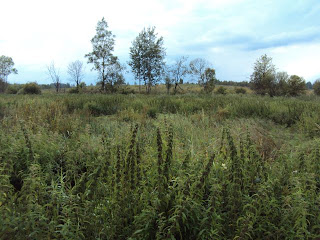August 6–16th 2012, two years since I was last in St Petersburg and since I first came on this dig in the Smolensk region of Russia with the State Hermitage Museum. I was a little nervous, but it felt like I'd been away for a month and was picking up where I'd left off. It is a such a beautiful place, so wild and in the middle of nowhere, so much green and so many trees (and mosquitoes, horse flies and wasps!). Velizh the nearest town is at least 25 minutes drive away.
The path to the camping area in the forest.
Morning and day views from my tent.
My tent, brrr it was so cold, partly because I only had an RSPB blanket to sleep on, but it was actually really cold, unlike 2010 when it was freakishly hot. Anyway, I got a camping bed after 4 days which helped enormously.
The striking white birch.
The drawing office, my desk.
The fire and dining area
Views around where we camped.
The dig vehicles.
Evening views
The mist still filled the wild field every evening.
Dig site 2: where there were 4 pile-dwelling homes.
They dive to find artefacts in the silt bed of the river.
There is also a pump that removes water and small artefacts are often found in this water.
Yummy lunch of pig fat, rye bread and tomato and salt.

Dig site 1: where they found the fishing fence and net sections.
The scenery around the sites. I went along to understand the vegetation and area, so I could draw it for them.
On the way back the truck got stuck in mud and the guys in the front truck had to push us out. It was really exciting.
There are lots of woodpeckers and when they cut down trees for firewood they found these woodpecker holes.
It was really cold so we had to sit like little old ladies next to the fire a lot.
15th of August is archaeology day and it was also 50 years of the Serteya dig, so a big celebration dinner was prepared by all.
Vadim! He's a dude. They are all lovely people and I'm so grateful for this slightly random, but enriching experience. Katia always seems to find the next challenge for me drawing and I feel my ability is really appreciated there. I hope to go back in 2 years time again.
The last stop on the 12 hour bus journey before St Petersburg.
My drawings from the dig
These artefacts are 4-5,000 years old and are from Neolithic civilization, pre-farming. But as Yol told me, it is the beginning of politics and of society as we know it, one of the indicators being that men and women were buried differently.
A bone spear tip.
A fishing net sinker made of clay wrapped in reed.
A fishing net sinker made of stone wrapped in reed.
Part of the fishing net they found with sinkers and reeds twisted to make the net and attached the sinkers.
A reconstruction drawing of what the fishing net and fence they found would have operated.
Fishing trap inoperative.
Fishing trap operative.
A pile-dwelling home.
A reconstruction drawing of the landscape and the 4 pile-dwelling houses next to the river with a lake in the distance and in the foreground.

































































